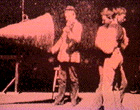Part of Fall 1996
What’s in a name? Just ask Tom.
Kalin brings a poet’s eye and a survivors understanding to the AIDS epidemic, managing work that is both personal and political, humorous and melancholic. Best known for his luscious feature debut Swoon, these brief, beautiful and intoxicating shorts are amongst the most moving documents of this generation. If your crotch had tear ducts the world would look like this.
Tom Chomont takes us on a trip to the dark side of the avant-garde. Spanning some thirty-five years, the program begins with his silent rapid montage diary flicks and leaves us with new work for the small screen Ñ homebrewed S/M videos which mark the relation of power and knowledge onto the body.
Chomont began working in the early sixties, eventually producing over forty short films and a raft of new videos in the 90’s. His work is characterized by a home movie manufacture, his cast often drawn from lovers and friends, hustlers and neighbors. Erotic rituals for the end of the century.
Notes:
They Are Lost To Vision Altogether
Short Works by Tom Kalin & Tom Chomont
The Short Videos of Tom Kalin:
Gesicht 2 min. 1986
Sight Unseen 1.5 min. 1986
A Confirmed Bachelor (Tom Kalin & Susan Strine) 2:30 min. 1994
That Poured its Hot Breath (work in progress) 3.5 min. 1996
Finally Destroy Us 4 min. 1991
Nation 1 min. 1992
Nomads 5 min. 1993
Darling Child 2 min. 1993
Kissing Doesn’t Kill by Gran Fury 30 sec. 1990
I Hung Back, Held Fire, Danced and Lied 5 min. 1996
Information Gladly Given but Safety Requires Avoiding Unnecessary Conversation
1:10 min. 1994
The opening two shorts of the program denote the way in which social space, and the images which inhabit it, come to inhabit us also. In the first, Gesicht takes aim at museum culture, showing well preserved specimens of our ancestors which seem to be looking back at the Sunday afternoon crowds. In Sight Unseen , a blindfolded man turns in a vertiginous and virtuosic display in a city of signs.
A Confirmed Bachelor tosses petals and blossoms at a fundamentalist Doctor’s pseudo-medical commentary on the in’s and out’s of gay male carnality. This humorless spew of turgid imagination is snatched from The Gay Agenda, a homophobic agit-prop tape distributed in the U.S. Senate by the Christian Radical Right in 1993. A collision of disco hooks, floating quotes and ripe images of nature, A Confirmed Bachelor allows the language of medical pathology to dissolve into absurdity right before our eyes, smothering it in a blanket of blooms. (V/Tape Catalogue)
Like much of Kalin’s work in the 90s, That Poured its Hot Breath draws its material from his super-8 single-frame diaries, now drawn in two elemental movements. The first, photographed in black and white, centres round images of fire, while the second is set by the sea. These moments of men on vacation are cleaved by a text which reads: “His heart was a dark cave filled with sharp toothed, fierce clawed beasts that ran snapping and tearing through his blood. In pain he left the worktable and prowled through the room, singing to himself, Who can I be tonight? Who will I be tonight?” Periodic shots of a grave follow, and a farcical song which draws its poignancy from the knowledge of all they have left behind. Hot Breath is a narrative of off-screen space, its interludes of remembrance punctuated by a furious concrete sound score.
Finally Destroy Us is a formalist’s scrapbook, framed by images of divers turning in arrested motion against an impassive sky. If their ascent is swift and graceful, it carries with it the knowledge that all too soon this moment will be carried away by gravity. These instants too quickly visited, too quickly receding into history, are memorialized here with a rare power. As the track croons, “Everytime we say good-bye I die a little” a succession of portraits, each glimpsed in passing, flicker past. Invariably photographed in close-up, this accretion of detail suffuses the whole with an exquisite nostalgia, these faces never to be seen again. The title is copped from Virginia Woolf who wrote: “These meetings, these partings, finally destroy us.”
Nation was commissioned by the Whitney Museum of American Art and The American Center in Paris as part of their international Trans Voices Project. Nation whizzes through questions of nations and nationality in a dense single minute. Borrowing the language of geography to consider individual bodies through topography, Nation reminds us that our bodies, like land, have been shaped by history into a series of zones to be charted, conquered, divided or made whole… Nation tries to think locally and globally at the same time. (Not without a healthy dose of irony by way of Benneton or Michael Jackson). (V/Tape Catalogue)
In Nomads Kalin offers up a globe seen in passing, glimpses of a supernal natural world juxtaposed with travelers of every kind – pixillated city traffic, airplanes and trains. This world in motion is offered up in a rapid fire, impressionistic montage, each glimpse viewed in a whirlwind of contingency. But however fleeting, Kalin manages to endow his nomadolgy with a grace and splendor, all propelled by Brian Eno’s Third Uncle.
Darling Child is a portrait of a room, and all those who might have inhabited it. Interspersed with these domestic interiors and a succession of longing looks outside is a text by Truman Capote which flashes between these impressions. “But we are alone, darling child, terribly, isolated each from the other; so fierce is the world’s ridicule we cannot speak or show our tenderness; for us death is stronger than life, it pulls like a wind through the dark, all our cries burlesqued in joyless laughter; and with the garbage of loneliness stuffed down us until our guts burst bleeding green, we go screaming round the world, dying in our rented rooms, nightmare hotels, eternal homes of the transient heart.” (Truman Capote)
Kissing Doesn’t Kill . Tom Kalin and Gran Fury produced four of these spots – smart, sexy, funny – each of them variations on a theme. This is the first of these 30 sec. interventions.
I Hung Back, Held Fire, Danced and Lied
This kinetic memorial proffers a series of quick-time portraits comprised of glances rather than stares, underlining the momentary and elusive thrall of encounter. Interspersed are names of the dead – Stuart Marshall and Vito Russo are amongst their number – providing a personal roll call of those who have fallen to the ravages of AIDS. All of these pixillated moments of encounter are fueled by the faux naive pop styling of Brian Eno’s Some of Them Are Old.
Information Gladly Given, but Safety Requires Avoiding Unnecessary Conversation
Similar to Nation this one minute tape explores, in short sequences, the desire to reclaim a social and public space.
Tom Chomont; Sadistic Self Portrait:
Oblivion 6 min. 1969
Minor Revisions 11 min. 1979
Razor Head 6 min. 1984
Slash Portrait for Clark 6.5 min. 1994
A Faustian Knot by Tom Chomont and Clark Coleman 8.5 min. 1994
Oblivion summarizes a series of encounters between the filmmaker and a young neighborhood hustler. Cast in an objectifying stare, Oblivion joins a few moments – the hustler smoking, taking off his shoes, department store lights, an apple held and split, and replays them in a furious montage which teases erotic longings from each of them. The film closes with a blue- hued shot of a tree in winter, signaling the end of desire. “There is always a tension for me between the fact of seeing someone from the outside – as a body, an object – and seeing the identity dissolution that usually takes place during sleep. If it happens when we’re awake, it’s disturbing, we want to avoid it… When something sexual seems impossible or unthinkable, fantasies are horribly exciting, horribly intense; yet I think that’s the beginning of seeing other people as part of your own concept of reality, and that makes it hard to break through to other people as they really are.” (Tom Chomont in “A Critical Cinema” by Scott MacDonald)
Minor Revisions is a portrait of the filmmaker’s lover who has unexpectedly decided to join the U.S. army. Chomont drafts a brief of leave taking via domestic metaphor – isolating glimpses shot indoors and collaging them together to provide a farewell that is at once lament and prophecy. Utilizing a series of solarized fruits and vegetables as metaphor for sexual union, separation and the ineffable layers of identity, the filmmaker teases from these simple feast preparations a summary of their time together and eventual release. These vegetable close-ups close with an image of an onion, infinitely peeled, suggesting the myriad identities contained in a single flesh. Chomont also turns the camera on himself, glimpsed in a distorting mirror, his shifting visage trying to fix the flow of the present without success, then giving himself over to a masturbatory reverie in expectation of his lover’s absence.
Razor Head depicts a shaving ritual, photographed over the course of an afternoon. The initiate is bound and snipped, before a careful cross-hatch razoring re-marks his hairline in a grid formation. These squares are lathered and shaved away. He then appears spread-eagled and naked while his barber sets to work removing his remaining body hair. He is released at last, hairless, and ready to begin work.
Slash Portrait for Clark
This tape is a home movie portrait of the filmmaker’s lover, glimpsed at first in a chair, smiling in ease as video treatments lend a shimmering auratic light to the scene, as if there were visible heat rising from his body. Like traditional photo portraiture, Chomont hopes to evoke from the body’s surface, and its accouterments – some inner truth about its subject. In this tradition of portraiture you can always tell a book by its cover. These early shots continue to cycle over another domestic scene. A slave, naked save for boots and cap, bends down to lick Clark’s boots, then masturbates as he writhes beneath the foot of his top. A kaleidoscope of impressions ensue, each accumulating on top of another as the film progresses, reminding us that the body never forgets, that the body is both the writer and book of its own history.
A Faustian Knot by Tom Chomont and Clark Coleman
Oozing mandala shapes and strobe lit faces testify to hidden blood secrets, while the low toned chanting and organ music give these impressions the unmistakable feel of a ritual at work. But unlike the public remonstrations of ritual familiar to most – the mass or ball game – these Sunday ministrations are delivered in private, indeed much of the film appears as if shot inside the body itself. Nonetheless, the aim in both instances is the same: transformation, ecstasy and deliverance. A priest arrives in leather, masked, wearing a cloak – he tortures the supplicant’s cock with cigarettes, offers blood from a chalice, burns his cock. He binds the face, slaps his balls, binds and pulls on his cock. The Faustian knot of the title? That knowledge of the self necessarily bears a price, that in order to pass over the limits of usual understanding we need to subject ourselves to ourselves, to the terrifying journey inwards.
Program Notes by Mike Hoolboom

